Ellis,J. Pressure transients in water engineering, A guide to analysis and interpretation of behaviour
Подождите немного. Документ загружается.

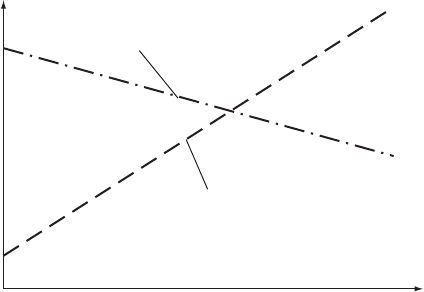
Pump power requirements are correspondingly smoothed by this
approach. Figure 10.21(b) shows typical output from either a double-
acting single cylinder or single-acting twin cylinders. Figure 10.21(c)
shows flow from a three-cylinder single-acting unit. Built-in accumula-
tors (small air cushions) are often included on suction and delivery
branches as a means of smoothing flow. Behaviour of air vessels is
discussed in Chapter 12.
Using the turbine pump form of performance curves of head and
power against flow for these pumps produces almost vertical gradients
and for practical use it is more convenient to use curves of flow and
power as a function of head as illustrated in Fig. 10.22.
10.10.2 Pneumatic ejector
For sewage applications involving small flows and requiring the
capability to pass solids of up to say 100 mm diameter it is not practical
to make a centrifugal pump capable of meeting both of these criteria.
One solution is to use a pneumatic ejector, the main components of
which are shown in Fig. 10.23. A compressor delivers air to a receiver.
Sewage flows enter via gravity sewers to collect in ejector cylinders. A
float is located in each cylinder and when this float rises to a defined
level the air inlet valve to that cylinder opens to allow air to enter
thus pressurising the contents of the cylinder. When sufficient pressure
has developed to overcome pressure in the outlet pipeline system then a
non-return valve opens automatically to permit discharge of the ejector
152
Power P against head H
p
Flow Q against head H
p
P and Q
H
p
Fig. 10.22. Performance curves for displacement pumps. (Performance curves of
turbine-type pumps are not convenient due to steepness of H—Q and P—Q
curves)
Pressure transients in water engineering
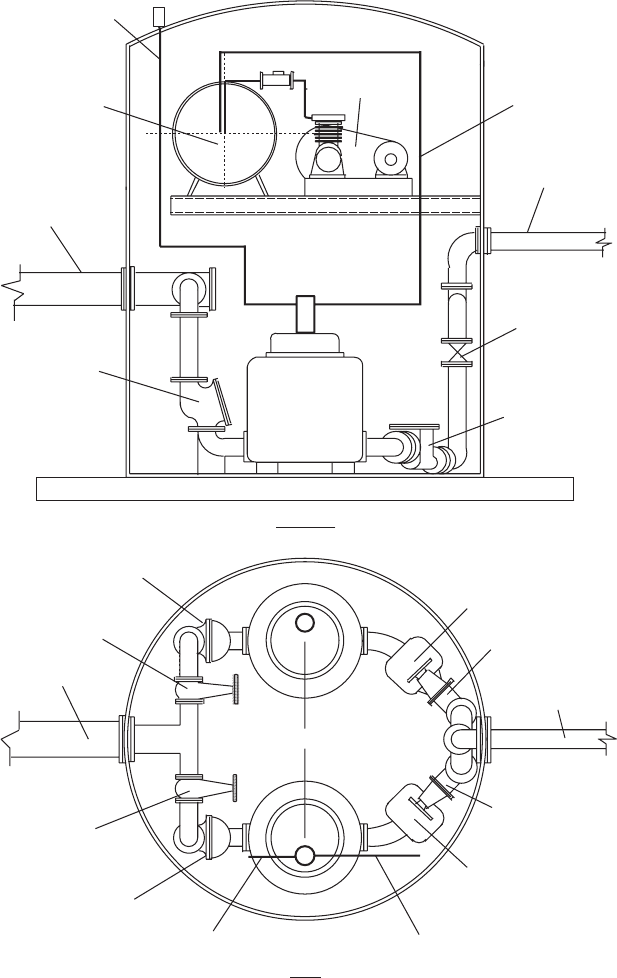
153
Check valve
Check valve
Air vent pipe
Compressed
air receiver
Inlet gravity sewer
Check valve
Check valve
Air compressor
Compressed air
supply pipe
Discharge
pressure pipe
Isolating valve
Ejector cylinder
Ejector cylinder
Elevation
Plan
Check valve
Check valve
Isolating valve
Isolating valve
Isolating valve
Isolating valve
Inlet gravity sewer
Air exhaust pipe
Air supply pipe
Discharge
pressure pipe
Fig. 10.23. Components of ejector station
Pumps
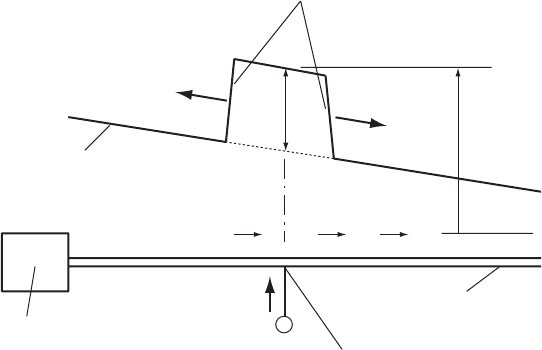
cylinder contents to the downstream pipeline system. Twin cylinders
are often provided with one filling while the other is discharging.
Usually one compressed air system supplies both cylinders. Overall effi-
ciency will typically be in the range 20—50%. Ejector stations are
designed to handle flows from isolated premises or groups of houses at
inflow rates of between 1 litre/s to 10 litres/s at delivery heads of up to
a maximum of about 30 mWG.
Each operation of an ejector cylinder will produce a transient within
the downstream pipeline system. Ejectors are normally rated according
to the size of cylinder, for example 150 litres, 250 litres. Discharge
normally will be completed in around 60 s so that corresponding
average flow would be 2.5 litres/s or 4.2 litres/s. Actual discharge rate
may well exceed these values, possibly reaching twice the average, i.e.
5.0 litres/s or 8.4 litres/s, if the air supply is generous. In a DN 100
rising main this would produce a velocity change of 0.6—1.1 m/s and
a corresponding inertial pressure rise.
It is not uncommon to find several ejector stations teed into a rising
main which also acts as a collector pipeline for these stations. Each time
an ejector operates it will induce a pressure transient within the rising
main. The flow rate from the ejector will be dependent to some
extent upon the piezometric level in the rising main. Figure 10.24
illustrates this situation with flow from the pumping station into the
rising main.
154
Datum
V
u/s
Q
e
dx/dt = V – a
dx/dt = V + a
V
d/s
+
Pressure waves travelling upstream and downstream
from ejector connection
Steady flow piezometric line
Pumping station
E
j
ector station connection
Collector/rising main
DH
H
Fig. 10.24. Operation of an ejector station on a sewage rising main
Pressure transients in water engineering
If the discharge from the ejector is Q
e
then with reference to Fig. 10.24
the equations required for solution at the ejector connection are:
from characteristics
Jþ¼V
u=s
þ g=aH and J¼V
d=s
g=aH
and from conservation of volume
V
u=s
A þ Q
e
¼ V
d=s
A
eliminating V
u=s
and V
d=s
then,
H ¼ðJþJþQ
e
=AÞ=ð2g=aÞð10:11Þ
To obtain an idea of the magnitude of the inertial pressure rise caused
by an ejector, assume that there is no time for wave reflections to occur
prior to the maximum discharge from the ejector being achieved. Then
if Jþ and J remain at their initial steady flow values, the initial head
H
o
at the ejector connection before discharge Q
e
occurs will be:
H
o
¼ðJþJÞ=ð2g=aÞ
and when the maximum discharge from the ejector is Q
e
max
, maximum
head will be:
H
max
¼ H
o
þ Q
e
max
=ð2Ag=aÞ
or peak inertial head
H ¼ Q
e
max
=ð2Ag=aÞð10:12Þ
Suppose Q
e
max
¼ 5 litres/s, D ¼ 300 mm (A ¼ 0:0707 m
2
) and a ¼
1000 m/s. The maximum inertial head increase will be:
H ¼ 0:005=ð2 0:0707 9:81=1000:0Þ¼3:6m
In a smaller main, say D ¼ 200 mm,
H ¼ 0:005=ð2 0:0314 9:81=1000:0Þ¼8:1m
The smallest sewage rising main may have diameter D ¼ 100 mm
giving: H ¼ 0:005=ð2 0:00785 9:81=1000:0Þ¼32:4m.
In a plastic rising main these inertia head values would be reduced
proportionately for the smaller wave speed in these pipes.
10.10.3 The hydraulic ram
This pump is an example of a device which produces a hydraulic
transient for the purpose of lifting water to a higher level. The
155
Pumps
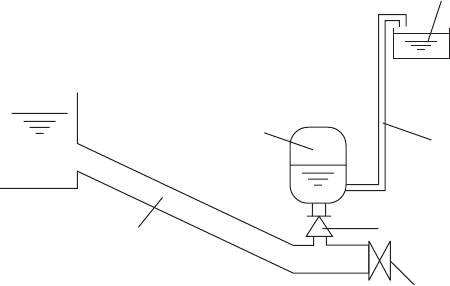
principle of operation may be illustrated with reference to Fig. 10.25.
The supply pipeline has to have sufficient length and diameter that a
worthwhile amount of kinetic energy is contained within the flow,
typical lengths being between 5 and 20 m. The air vessel is located
from 0.5 to 3 m below the water surface in the supply reservoir and
the difference in level between the supply reservoir and the waste
valve can be up to 6 m. If the waste valve is suddenly closed the
water column in the supply line is rapidly decelerated with an atten-
dant pressure rise. This rising pressure pushes upon the non-return
delivery valve, allowing flow to enter the air vessel and pressurise this
chamber, causing flow to pass through the riser pipe into the elevated
storage tank. Once flow in the supply line comes to rest and starts to
reverse, pressure below the delivery valve falls and this valve closes.
Falling pressure can also be used to reopen the waste valve allowing a
further cycle of operation to commence. Overall efficiency of the
process is around 50%.
The hydraulic ram has been described as an hydraulic transformer
converting low pressure into high pressure.
10.10.4 The jet pump
Jet pumps or injectors operate by transference of momentum from a
high-velocity jet of ‘motive’ fluid to a ‘pumped’ fluid medium within a
mixing tube (Fig. 10.26). A jet pump may be installed in a borehole
with a centrifugal pump at the surface providing the motive force for
the jet pump.
156
M
Supply
reservoir
Air vessel
Supply pipeline
Fast-closin
g
valv
e
Non-return valve
Header tank
Riser
M
Fig. 10.25. Schematic of hydraulic ram
Pressure transients in water engineering
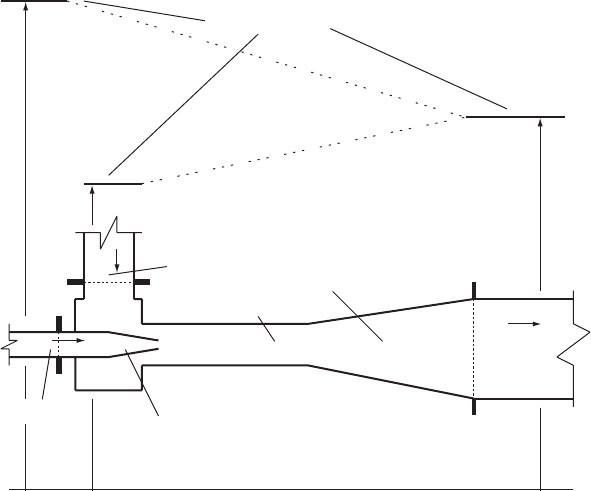
The performance of this unit is described using two quantities. The
relationship between pumped mass flow and motive mass flow is
called the flow coefficient q, thus:
q ¼
p
Q
p
=ð
m
Q
m
Þ
Or in the case where water comprises both motive and pumped media:
q ¼ Q
p
=Q
m
ð10:13Þ
the pressure or head relationship Z for a jet pump can be defined as:
Z ¼ðH
3
H
2
Þ=ðH
1
H
3
Þð10:14Þ
Efficiency of the pump is then:
¼ qZ ¼ Q
p
ðH
3
H
2
Þ=½Q
m
ðH
1
H
3
Þ ð10:15Þ
Performance curves for a pump of this type may have the form shown
in Fig. 10.27. In any analysis there are five unknowns: H
1
, H
2
, H
3
, Q
m
and Q
p
. The equations available for solution at any time comprise three
characteristic equations, the head relationship and the flow coefficient
157
1
2
3
H
1
H
2
Q
p
Q
m
H
3
Piezometric levels
Pumped fluid
Mixing tube
Diffuser
Motive fluid
Nozzle
Common horizontal datum
Q
p
+ Q
m
Fig. 10.26. Principles of a jet pump
Pumps

relationship. These are sufficient to yield values of the dependent
variables after each time increment.
When the jet pump is without moving parts it will merely act to
partially transmit and reflect transients developed elsewhere in the
pipeline system and does not of itself initiate any pressure transient
effects. Some jet pumps are fitted with a control valve, usually in the
form of a needle valve, which can be used for discharge regulation.
Should the valve setting be adjusted then the jet pump will initiate a
transient event.
158
Z–q
h–q
h, Z
q
Fig. 10.27. Performance curves for a jet pump
Pressure transients in water engineering

11
Flywheels
The concept of a reservoir of energy, however modest, being stored in
the rotating elements of a pumpset was established in the previous
chapter. The present section develops this idea as a means of surge
suppression by considering how the amount of energy, contained
within the rotating pump system, may be enhanced to improve the
ability to control rates of flow and pressure change at the pump after
it is tripped.
The rate of change of velocity at a pump determines the severity of
the hydraulic transient developed when the pump is started or
stopped. During start-up the changes in velocity will be controlled by
the mode of starting and to some extent any surge problems associated
with pump start can be designed out by an appropriate choice of starting
method. For instance, if rates of velocity increase produce unacceptable
surges then a flow control valve may be a possible remedy. This valve
can be used to regulate the way in which flow rate is allowed to
develop. During a ‘normal’ pump shutdown under either automatic or
operator control, the rate of deceleration of flow can again be
controlled. In the event of a power failure, on the other hand, the
pump speed and also pump discharge will reduce in a manner controlled
by the characteristics of the pumpset, liquid and pipeline system. The
only source of energy remaining to allow pumping to continue is that
stored within the rotating elements of pump, shafting and motor.
11.1 Moment of inertia
The stored energy E ¼
1
2
I!
2
in the rotating elements of a centrifugal
pump installation is dependent on the moment of inertia I ðkg:m
2
Þ
for a given speed of rotation ! (rad/s). As the pump decelerates
159
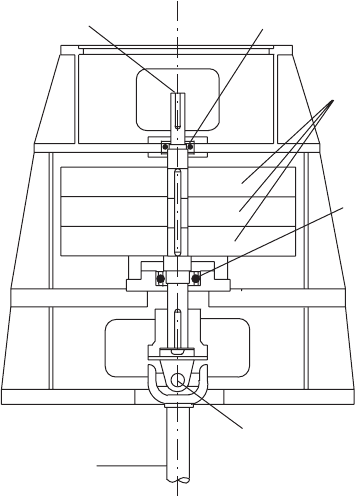
following a pumping failure, energy is transferred to the water from this
store of energy. Increasing the moment of inertia is an obvious way in
which the amount of stored energy can be increased. After a pump is
tripped, this additional energy in the rotating elements can be used
to prolong pumping thus reducing rate of flow deceleration dV=dt
and with it the severity of pressure transient effects. This increase of
moment of inertia can be achieved by adding a flywheel to each
pump/motor shaft. Shearing of the shaft between flywheel and pump
impeller will render the flywheel ineffective.
11.2 Flywheels
The flywheel consists of one or more metal disks rotating on the same
shaft as the pump and motor and with the same speed. Figure 11.1
shows a typical installation for a vertical pump.
On the delivery side of a pumping station after pump failure, the rate
at which head decreases and flow decelerates is reduced by adding
additional inertia. In the case of a booster station, on the suction side
of the station, rate of head rise and rate of flow deceleration are also
160
Shaft to electric motor
Upper bearing
Flywheel assembl
y
Lower bearing
Coupling
Shaft extending
downwards to pump
Fig. 11.1. Flywheel installation
Pressure transients in water engineering
reduced by adding a flywheel. After flow has ceased and the check valve
on each pump delivery branch has closed, the pump/flywheel arrange-
ment plays no further part in the transient event in a rising main. The
flywheel may have been added for the purpose of controlling either
minimum or maximum transient pressures in the main. Where peak
pressures are to be controlled then these will arise as a consequence of
deceleration of a reversed flow which has occurred subsequent to the
initial downsurge following pumping failure. The only way in which the
flywheel can limit such maximum pressures is by previously controlling
these initial minimum piezometric levels. The adverse hydraulic gradient
producing flow deceleration and accelerating flow in the reversed
direction in the main is thus limited. So it is only by limiting the
initial downsurge that the subsequent upsurge is controlled.
The flywheel forms an integral part of the pumpset assemblage and it
is speed change of the machine that initiates the transient event. By
adding the flywheel the rates of speed change are reduced and the
pressure transient is controlled at its source. The entire system benefits
from the flywheel solution. This contrasts with some other forms of
surge alleviation in which the hydraulic transient is allowed to
develop and its subsequent spread through the majority of a pumping
system is restricted by additional surge equipment. Reducing rates of
velocity change at the pump itself gives check valves time to respond
thus reducing potential for valve slam. The same applies during pump
start if the flywheel means that a slower acceleration of pump occurs.
The check valve will not then be thrown open.
This form of hydraulic transient suppression also has the advantage of
ease of maintenance.
Where a gearbox is included, relative speeds of pump and motor
require to be considered (Miller, 1978). Resultant inertia is expressed
in terms of pump speed so that
I ¼ I
imp
þ I
shaft
þ I
motor
f!
motor
=!
pump
g
2
11.3 Limitations on flywheel size
Sometimes the size of flywheel which can be added is limited by one or
more factors. The extent to which inertia can be increased is usually
determined by capability of the motor and starting equipment. Limita-
tions on the power of motor that can be operated using direct-start
means have already been mentioned in Chapter 10. To illustrate the
potential limitation of the flywheel solution, in one Middle East
161
Flywheels
